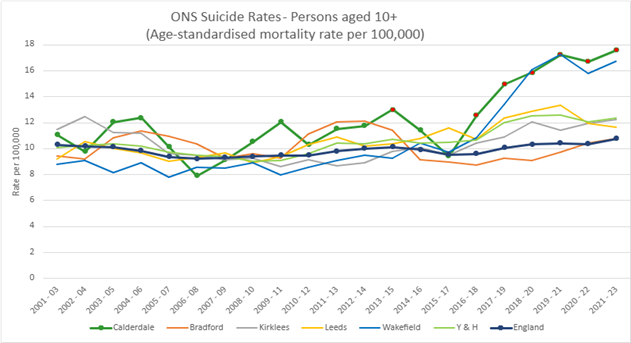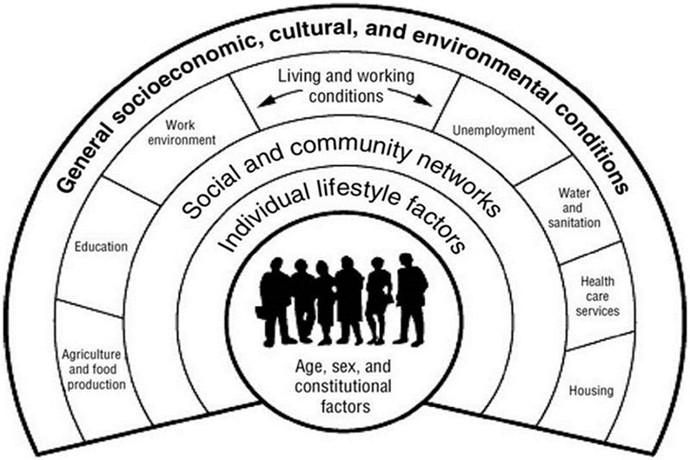Introduction
Calderdale Wellbeing Strategy 2022-2027 goal for working age people is to have good emotional health and wellbeing and fewer suicides. There are strong moral and economic reasons to support this:
- People with poor emotional wellbeing have poorer outcomes overall. (Wasterhof & Keyes, 2009).
- People with moderate levels of mental wellbeing have better relationships, physical health, and productivity at work. (Keyes, 2012).
- Nationally it is estimated that halving the number of adults with poor wellbeing could generate £54 billion in annual benefits. (ProBono Economics, 2024).
We also know that some groups of people have much better outcomes than others, which is unfair and unequal. We have produced a strength and needs assessment. This is to understand how to improve outcomes for working age adults in Calderdale.
A high level summary of the findings and recommendations can be found on Living and Working Well. This section of the website explains the aims and methods and introduces the different factors identified.
Aim
The aim of this assessment is to identify the risk and protective factors in Calderdale which influence the emotional health and wellbeing and the risk of suicide of the working age population.
The strengths and needs assessment will also make recommendations for improving these outcomes. Particularly for people who are at highest risk of poor outcomes.
Scope
This report focuses on factors affecting emotional health and wellbeing and suicide. It does not include a detailed review of mental health disorders and mental health treatment services.
- Age: Government statistics consider working age to be 15 – 64 years (Working age population (2023))
- Employment status: People both in and out of paid work.
- The current state pension age is 66 years, rising to 67 years between May 2026 and March 2028. The needs assessment will not exclude people aged 65-66 from any local work. But they may not be covered in national statistics reported.
The needs of all those aged over 50 years in Calderdale is considered in Ageing Well.
Objectives
- Review current literature and collate protective and risk factors impacting on emotional health and wellbeing and suicide.
- Obtain, collate, and review up to date local and national data on emotional health and wellbeing and suicide.
- Identify local assets providing protective factors for emotional health and wellbeing and suicide prevention and gather and report insights.
- Identify health and healthcare inequalities such as gaps in local provision or differences in outcomes between different groups of people.
- Provide evidence of need to support the development of local evidence-based commissioning priorities.
- Recommend priority areas for action for each protective factor.
- Produce an accessible report. This covers strengths and needs in Calderdale affecting emotional health and wellbeing and suicide prevention for the working age population.
The accessible report is being published on Living and Working Well from June 2025.
Baseline outcomes
Emotional health and wellbeing in Calderdale
A local survey in October 2021 found that 57% of the working age population in Calderdale had good mental wellbeing. A follow-up survey in 2023 did not get enough people responding to give a good picture. Ways of getting better local data are being explored.
We can compare Calderdale to England for four measures of emotional health and wellbeing. This is from data from the national Annual Population Survey.
- Anxiety.
- Happiness.
- Life satisfaction.
- Feeling that life is worthwhile .
Table 1 shows that people in Calderdale are like the rest of England in all four measures of wellbeing. Results have remained similar across the last three years.
| Measures of wellbeing | Location | 2020/21 | 2021/22 | 2022/23 |
|---|---|---|---|---|
| Low Anxiety | Calderdale | 55.64 | 61.73 | 56.71 |
| Low Anxiety | England | 57.03 | 59.82 | 58.36 |
| Happiness | Calderdale | 72.51 | 76.58 | 69.22 |
| Happiness | England | 71.96 | 74.8 | 73.88 |
| Life satisfaction | Calderdale | 73.19 | 79.31 | 78.21 |
| Life satisfaction | England | 76.34 | 79.97 | 78.02 |
| Worthwhile | Calderdale | 81.01 | 80.74 | 80.52 |
| Worthwhile | England | 81.66 | 82.94 | 81.72 |
Please note: Differences between years or between locations would need to be greater than 10% to not be considered due to chance. This is due to small sample sizes.
Suicide rates in Calderdale
Since 2016-18, the rate of suicide in Calderdale has been consistently higher than regional and national averages. In 2021-23 the rate in Calderdale was 17.6 per 100,000 compared to 10.7 per 100,000 in England.

Definitions
Emotional health and wellbeing
This report uses the terms ‘mental wellbeing’ and ‘emotional health and wellbeing’ to mean the same thing.
Mental (emotional) wellbeing is defined as:
The ability for an individual to develop their potential, work productively and creatively, build strong positive relationships with others, and contribute to the community. (World Health Organisation, 2004).
Emotional wellbeing is more than not having a mental illness. People with mental illness can still have good mental wellbeing.
“Mental illness and ‘well-being’ are not ends of the same continuum. It is possible to have high levels of subjective well-being despite having a mental illness, and vice versa.” (Chief Medical Officer, 2013)
Suicide
Suicide is the act of intentionally taking your own life. Suicide and self-harm are not mental health problems themselves but are linked with mental distress (Public Health England , 2019).
How this report was written
We carried out a rapid review of published literature along with local and national policy documents. This was to identify factors which affect risk of poor emotional or mental wellbeing or suicide. We also included groups and factors identified locally through discussions with partners across Calderdale.
The data discussed in this report included:
- Place-based and national datasets and intelligence.
- Case studies.
- Community insight.
- Local voices.
- Service user feedback.
The national datasets used include open data sources such as Fingertips and the Office of National Statistics Census. The Public Health Intelligence team or Calderdale Council Business Intelligence team interrogated these datasets. We have provided descriptive and inferential statistics where applicable.
We included local datasets and qualitative data and service user feedback. These came from a range of published and unpublished sources and could be shared in a public document.
Collaboration with colleagues from across the Council and statutory and voluntary sector partners in Calderdale and West Yorkshire. This led to the identifications of strengths and needs and the development of the recommendations.
Assessment structure
Over 20 different risk and protective factors and personal characteristics were identified through the evidence review. These affect emotional health and wellbeing and risk of suicide
In figure 1 we used four categories from Dahlgren and Whitehead’s Social Determinants of Health model. This was to organise reporting into four main sections.

Figure 1 (Dahlgren and Whitehead, 1991)
Figure 1 is a diagram to illustrate all the factors which affect a person’s wellbeing. The centre of the diagram is a circle showing people, and the words “age, sex and constitutional factors”. There are four semi-circular layers surrounding the inner circle. The layer closest to the circle has the words “individual life style factors”. The second “social and community networks”. The third layer represents living and working conditions. It has the words “agriculture and food production”, “education”, “work environment”, “unemployment”, “water and sanitation”, “health care services” and “housing. The final layer says “general socioeconomic, cultural, and environmental conditions”.